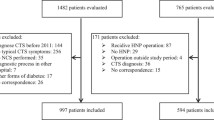Abstract
Background
Although carpal tunnel syndrome is the most common compressive neuropathy, there is no comprehensive theory of its etiology. Because of the prevalence of night symptoms, we are interested in the role of sleep position in the causation of carpal tunnel syndrome.
Methods
We performed a case–control study comparing the prevalence of preferred sleep position in 68 cases and 138 controls. Analysis was stratified by age and gender and controlled for body mass index.
Results
We found a strong and significant association between a preference for sleeping on the side and the presence of carpal tunnel syndrome in men and in women less than 60 years of age. Body mass index was associated with carpal tunnel syndrome in women but not men.
Conclusions
Our findings of a strong association between the presence of carpal tunnel syndrome and preferred sleeping on the side suggest a comprehensive unifying theory of causation.



Similar content being viewed by others
References
Atroshi I, Gummesson C, Johnsson R, Ornstein E, Ranstam J, Rosen I. Prevalence of carpal tunnel syndrome in a general population. JAMA. 1999;282:153–8.
Atroshi I, Gummesson C, Ornstein E, Johnsson R, Ranstam J. Carpal tunnel syndrome and keyboard use at work: a population-based study. Arthritis Rheum. 2007;56(11):3620–5.
Atroshi I, Lyren PE, Gummesson C. The 6-item CTS symptoms scale: a brief outcomes measure for carpal tunnel syndrome. Qual Life Res. 2009;18(3):347–58.
Bland JD. The relationship of obesity, age, and carpal tunnel syndrome: more complex than was thought? Muscle Nerve. 2005;32:527–32.
Bland JP, Rudolfer SM. Clinical surveillance of carpal tunnel syndrome in two areas of the United Kingdom, 1991–2001. J Neurol Neurosurg Psychiatry. 2003;74:1674–9.
Bower JA, Stanisz GJ, Keir PJ. An MRI evaluation of carpal tunnel dimensions in healthy wrists: implications for carpal tunnel syndrome. Clin Biomech. 2006;21:816–25.
Boz C, Ozmenoglu M, Altunayoglu V, Velioglu S, Alioglu Z. Individual risk factors for carpal tunnel syndrome: an evaluation of body mass index, wrist index, and hand anthropometric measurements. Clin Neurol Neurosurg. 2004;106:294–9.
Farmer JE, Davis TRC. Carpal tunnel syndrome: a case–control study evaluating its relationship with body mass index and hand and wrist measurements. J Hand Surg Eur. 2008;33(4):445–8.
Graham B. The value added by electrodiagnostic testing in the diagnosis of carpal tunnel syndrome. J Bone Joint Surg Am. 2008;90(12):2587–93.
Graham B, Regehr G, Naglie G, Wright JG. Development and validation of diagnostic criteria for carpal tunnel syndrome. J Hand Surg. 2006;31A:919–24.
Gupta R, Rummler L, Steward O. Understanding the biology of compressive neuropathies. CORR. 2005;436:251–60.
Kamolz L-P, Beck H, Haslik W, Hogler R, Rab M, Schrogendorfer KF, et al. Carpal tunnel syndrome: a question of hand and wrist configuration. J Hand Surg. 2004;29B(4):321–4.
Katz JN, Larson MG, Sabra A, Krarup C, Stirrat CR, Sethi R, et al. The carpal tunnel syndrome: diagnostic utility of the history and physical examination findings. Ann Intern Med. 1990;112:321–7.
Katz JN, Stirrat CR, Larson MG, Fossel AH, Eaton HM, Liang MH. A self-administered hand symptom diagram for the diagnosis and epidemiologic study of carpal tunnel syndrome. J Rheumatol. 1990;17(11):1495–8.
Keller RB, Largay AM, Soule DN, Katz JN. Maine Carpal Tunnel Study: small area variations. J Hand Surg. 1998;23A:692–6.
Kubota T, Ohshima N, Kunisawa N, Murayama R, Okano S, Mori-Okamoto J. Characteristic features of the nocturnal sleeping posture of healthy men. Sleep Biol Rhythms. 2003;1:183–5.
Lozano-Calderon S, Anthony S, Ring D. The quality and strength of evidence for etiology: example of carpal tunnel syndrome. J Hand Surg Am. 2008;33(4):525–38.
Mackinnon SE. Pathophysiology of nerve compression. Hand Clin. 2002;18(2):231–41.
McCabe SJ, Uebele AL, Pihur V, Rosales RS, Atroshi I. Epidemiologic associations of carpal tunnel syndrome and sleep position: is thee a case for causation? Hand NY. 2007;2(3):127–34.
McCabe SJ, Xue Y. Evaluation of sleep position as a potential cause of carpal tunnel syndrome: preferred sleep position on the side is associated with age and gender. Hand. 2010. doi:10.1007/s11552-010-9271-y.
Moghtaderi A, Izadi S, Sharafadinzadeh N. An evaluation of gender, body mass index, wrist circumference, and wrist ratio as independent risk factors for carpal tunnel syndrome. Acta Neurol Scand. 2005;112:375–9.
Mondelli M, Giannini F, Giacchi M. Carpal tunnel syndrome incidence in a general population. Neurology. 2002;58:289–94.
Nathan PA, Keniston RC. Carpal tunnel syndrome and its relation to general physical condition. Hand Clin. 1993;9:253–61.
Nordstrom DL, Vierkant RA, DeStefano F, Layde PM. Risk factors for carpal tunnel syndrome in a general population. Occup Environ Med. 1997;54:734–40.
Padua L, Aprile I, Caliandro P, Carboni T, Meloni A, Massi S, et al. Symptoms and neurophysiological picture of carpal tunnel syndrome in pregnancy. Clin Neurophysiol. 2001;112:1946–51.
Phalen GS. The carpal-tunnel syndrome. Seventeen years’ experience in diagnosis and treatment of six hundred fifty-four hands. J Bone Joint Surg Am. 1966;48A:211–28.
Radecki P. A gender specific wrist ratio and the likelihood of a median nerve abnormality at the carpal tunnel. Am J Phys Med Rehabil. 1994;73(3):157–62.
Stolp-Smith KA, Pascoe MK, Ogburn Jr PL. Carpal tunnel syndrome in pregnancy: frequency, severity, and prognosis. Arch Phys Med Rehabil. 1998;7:1285–7.
Wainner RS, Fritz JM, Irrgang JJ, Delitto A, Allison S, Boninger ML. Development of a clinical prediction rule for the diagnosis of carpal tunnel syndrome. Arch Phys Med Rehabil. 2005;86:609–18.
Weiss ND, Gordon L, Bloom T, So Y, Rempel DM. Position of the wrist associated with the lowest carpal-tunnel pressure: implications for splint design. J Bone Joint Surg Am. 1995;77:1695–9.
Werner RA, Albers JW, Franzblau A, Armstrong TJ. The relationship between body mass index and the diagnosis of carpal tunnel syndrome. Muscle Nerve. 1994;17(12):1491–3.
Author information
Authors and Affiliations
Corresponding author
About this article
Cite this article
McCabe, S.J., Gupta, A., Tate, D.E. et al. Preferred sleep position on the side is associated with carpal tunnel syndrome. HAND 6, 132–137 (2011). https://doi.org/10.1007/s11552-010-9308-2
Published:
Issue Date:
DOI: https://doi.org/10.1007/s11552-010-9308-2




